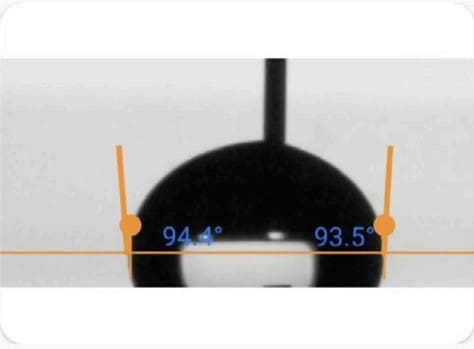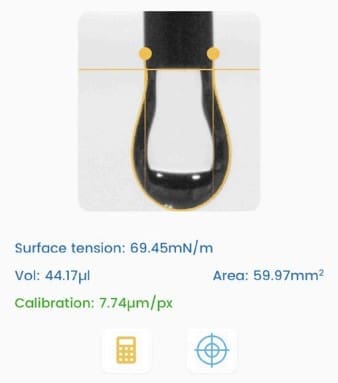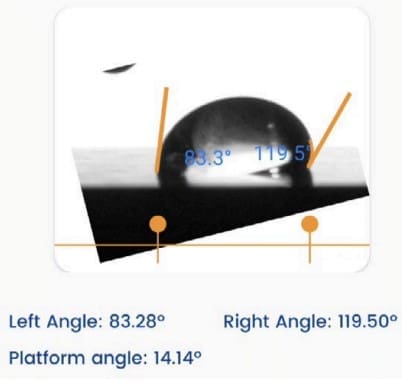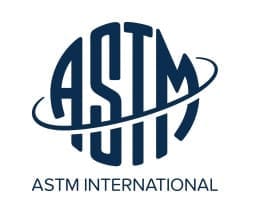Reviewed: 28
This is a practical guide to Surface Science for researchers working in the Industrial and Mechanical Industry.
In this all-new guide you’ll learn all about:
Let’s dive right in.

Surface properties play a fundamental role in the field of Mechanical and Industrial Engineering. The interaction of materials and components with the environment and other materials takes place primarily on surfaces. For example, the contact between two machine parts, the flow of fluids in pipes, or the adhesion of coatings to substrates. The outcome of all these interactions is influenced by surface properties. As such, they play a critical role on product design, manufacturing processes, and the overall performance of engineered systems. Therefore, understanding and controlling these properties are essential for achieving optimal performance, efficiency, and reliability in various industrial processes and applications.
We use the important surface properties below to understand the behavior of Industrial and Mechanical products and improve their quality.

Young – Laplace Method
Polynomial Method
Dynamic Contact Angle
Ideally, when we place a drop on a solid surface, a unique angle exists between the liquid and the solid surface. We can calculate the value of this ideal contact angle (the so-called Young’s contact angle) using Young’s equation. In practice, due to surface geometry, roughness, heterogeneity, contamination, and deformation, the contact angle value on a surface is not necessarily unique but falls within a range. We call this range’s upper and lower limits the advancing contact angle and the receding contact angle, respectively. The values of advancing and receding contact angles for a solid surface are also very sensitive. They can be affected by many parameters, such as temperature, humidity, homogeneity, and minute contamination of the surface and liquid. For example, the advancing and receding contact angles of a surface can differ at different locations.
Practical surfaces and coatings naturally show contact angle hysteresis, indicating a range of equilibrium values. When we measure static contact angles, we get a single value within this range. Solely relying on static measurements poses problems, like poor repeatability and incomplete surface assessment regarding adhesion, cleanliness, roughness, and homogeneity.
In practical applications, we need to understand a surface’s liquid spreading ease (advancing angle) and removal ease (receding angle), such as in painting and cleaning. Measuring advancing and receding angles offers a holistic view of liquid-solid interaction, unlike static measurements, which yield an arbitrary value within the range.
This insight is crucial for real-world surfaces with variations, roughness, and dynamics, aiding industries like cosmetics, materials science, and biotechnology in designing effective surfaces and optimizing processes.
Learn how Contact Angle measurement is done on our Tensiometer
For a more complete understanding of Contact Angle measurement, read our Contact Angle measurement: The Definitive Guide
This property measures the force that acts on the surface of a liquid, aiming to minimize its surface area.

Dynamic Surface Tension
Dynamic surface tension differs from static surface tension, which refers to the surface energy per unit area (or force acting per unit length along the edge of a liquid surface).
Static surface tension characterizes the equilibrium state of the liquid interface, while dynamic surface tension accounts for the kinetics of changes at the interface. These changes could involve the presence of surfactants, additives, or variations in temperature, pressure, and composition at the interface.
Dynamic surface tension is essential for processes that involve rapid changes at the liquid-gas or liquid-liquid interface, such as droplet and bubble formation or coalescence (change of surface area), behavior of foams, and drying of paints (change of composition, e.g., evaporation of solvent). We measure it by analyzing the shape of a hanging droplet over time.
Dynamic surface tension applies to various industries, including cosmetics, coatings, pharmaceuticals, paint, food and beverage, and industrial processes, where understanding and controlling the behavior of liquid interfaces is essential for product quality and process efficiency.
Learn how Surface Tension measurement is done on our Tensiometer
For a more complete understanding of Surface Energy measurement, read our Surface Tension measurement: The Definitive Guide

Learn how Surface Energy measurement is done on our Tensiometer
For a more complete understanding of Surface Energy measurement, read our Surface Energy measurement: The Definitive Guide
The sliding angle measures the angle at which a liquid film slides over a solid surface. It is commonly employed to assess the slip resistance of a surface.

Learn how Sliding Angle measurement is done on our Tensiometer
For a more complete understanding of Sliding Angle measurement, read our Sliding Angle Measurement: The Definitive Guide
Within the Industrial and Mechanical industry, several case studies exemplify the advantages of conducting surface property measurements.
Challenge: In the marine engineering field, maintaining the performance of underwater equipment such as bearings is critical.
Solution: Engineers have worked on hydrophobic bearings for submerged applications by creating low sliding angle surfaces. The hydrophobicity in bearings helps in reducing the friction between moving parts in underwater machinery, such as ship propellers and underwater vehicles. Lower sliding angles help in smoother operation, increased efficiency, and reduced wear and tear enhancing the reliability of marine equipment.


Challenge: In the aviation industry, ice formation on aircraft surfaces is a big concern. Ice accumulation on aircraft wings disrupts airflow which leads to reduced lift and control.
Solution: Engineers have worked on an anti-icing systems that depends on contact angles. By carefully controlling the contact angle superhydrophobic surfaces are created. It makes sure that ice cannot easily stick to the aircraft’s wings and surfaces. The new superhydrophobic surface enhanced safety by preventing ice accumulation and reduced the weight and energy consumption associated with traditional de-icing methods.
Challenge: In 3D Printing, controlling the surface tension of printing materials is essential for achieving precise and high-quality prints.
Solution: Engineers have developed 3D printing material that has relatively low surface tension. Lower surface tension promotes better wetting and adhesion of the printing material to the build surface and between successive layers. Therefore, the new 3D printing material will offer improved print quality, reduced defects such as warping and delamination, and enhanced overall printing reliability. It will help the 3D printing material spread evenly across the build surface, creating strong bonds between layers and will reduce the likelihood of issues like “elephant’s foot” (excessive material squishing at the first layer) or “stringing” (unwanted thin strands of material).


Challenge: The development of devices like Catheters requires blood-repellent surfaces to prevent clotting and ensure smooth functioning.
Solution: In the medical industry, a superhydrophobic coating with a high contact angle is applied to the surfaces of medical devices. This creates a non-wetting surface that can repel blood and other bodily fluids. The high contact angle prevents blood from sticking to the surface of medical devices, reducing the risk of clot formation. It enhances the overall performance and safety of these devices.
Challenge: In the automotive industry, it is important to maintain visibility during rain for driver safety.
Solution: In traditional windshield surfaces, water buildup is a common problem. It reduces visibility compromising driver safety. The industry has a unique solution to enhance rainwater repellency. A hydrophobic coating with a low sliding angle is applied to automotive windshields. The low sliding angle makes sure that rainwater easily slides off the surface. It improves visibility during wet conditions. The hydrophobic coating significantly reduces water buildup on windshields, leading to improved driver visibility and safety during rainy weather.

If you are interested in implementing these or any other applications, please contact us.
In an industry where precision reigns supreme, where do Industrial and Mechanical manufacturers turn to ensure their products can survive scrutiny? The answer lies in standards and guidelines: the compass that guides cosmetics manufacturers through the complex maze of quality and performance.

Halide ion chloride and fluoride ions can contribute to external stress corrosion cracking (ESCC) in the absence of inhibiting ions when deposited and concentrated on the surface of austenitic stainless steel. Therefore, this standard provides the test methods for laboratory procedures for the determination of water-leachable chloride, fluoride, silicate, and sodium ions in thermal insulation materials in the parts per million range.
We hope this guide showed you how to apply surface science in cosmetics industry.
Now we’d like to turn it over to you:
Droplet Lab was founded in 2016 by Dr. Alidad Amirfazli, faculty member at York University, and two of his researchers, Dr. Huanchen Chen and Dr. Jesus L. Muros-Cobos.
Dropletlab © 2024 All Rights Reserved.